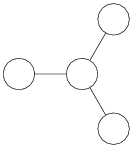nLab dihedral group
Context
Group Theory
- group, ∞-group
- group object, group object in an (∞,1)-category
- abelian group, spectrum
- super abelian group
- group action, ∞-action
- representation, ∞-representation
- progroup
- homogeneous space
Classical groups
Finite groups
Group schemes
Topological groups
Lie groups
Super-Lie groups
Higher groups
Cohomology and Extensions
Related concepts
Contents
Idea
Dihedral groups
The dihedral group, , is a finite group of order . It may be defined as the symmetry group of a regular -gon in the plane.
For instance is the symmetry group of the equilateral triangle and is isomorphic to the symmetric group, .
For , , the dihedral group is thus the subgroup of the orthogonal group which is generated from the finite cyclic subgroup of and the reflection at the -axis (say). It is a semi-direct product of and corresponding to that reflection, hence fitting into a short exact sequence as follows:
Under the further embedding the cyclic and dihedral groups are precisely those finite subgroups of SO(3) that, among their ADE classification, are not in the exceptional series.
Remark
Warning on notation
There are two different conventions for numbering the dihedral groups.
-
The above is the algebraic convention in which the suffix gives the order of the group: .
-
In the geometric convention one writes “” instead of “”, recording rather the geometric nature of the object of which it is the symmetry group.
Furthermore beware that there is yet another group commonly denoted “”, cf. at Coxeter group.
Binary dihedral/dicyclic groups
Under the further lift through the spin group-double cover map of the special orthogonal group, the dihedral group is covered by the binary dihedral group, also known as the dicyclic group and denoted
Equivalently, this is the lift of the dihedral group (above) through the pin group double cover of the orthogonal group O(2) to Pin(2)
Explicity, let be the quaternions realized as the Cayley-Dickson double of the complex numbers, and identify the circle group
with the unit circle in this way, with group structure given by multiplication of quaternions. Then the Pin group Pin(2) is isomorphic to the subgroup of the group of units of the quaternions which consists of this copy of SO(2) together with the multiples of the imaginary quaternion with this copy:
The binary dihedral group is the subgroup of that generated from
-
.
It is manifest that these two generators satisfy the relations
and in fact these generators and relations fully determine , up to isomorphism.
Properties
Group cohomology
The group cohomology of the dihedral group is discussed for instance at Groupprops.
As part of the ADE pattern
ADE classification and McKay correspondence
Group presentation
The dihedral group has a group presentation
From this it is easy to see that it is a semi-direct product of the generated by and the generated by . The action of on is given by .
It is a standard example considered in elementary combinatorial group theory.
Examples
Quaternion group and triality

The first binary dihedral group is isomorphic to the quaternion group of order 8:
In the ADE-classification this is the entry D4.
linear representation theory of binary dihedral group
dicyclic group quaternion group
| conjugacy classes: | 1 | 2 | 4A | 4B | 4C |
|---|---|---|---|---|---|
| their cardinality: | 1 | 1 | 2 | 2 | 2 |
| splitting field | with |
| field generated by characters |
character table over splitting field /complex numbers
| irrep | 1 | 2 | 4A | 4B | 4C | Schur index |
|---|---|---|---|---|---|---|
| 1 | 1 | 1 | 1 | 1 | 1 | |
| 1 | 1 | -1 | 1 | -1 | 1 | |
| 1 | 1 | 1 | -1 | -1 | 1 | |
| 1 | 1 | -1 | -1 | 1 | 1 | |
| 2 | -2 | 0 | 0 | 0 | 2 |
character table over rational numbers /real numbers
| irrep | 1 | 2 | 4A | 4B | 4C |
|---|---|---|---|---|---|
| 1 | 1 | 1 | 1 | 1 | |
| 1 | 1 | -1 | 1 | -1 | |
| 1 | 1 | 1 | -1 | -1 | |
| 1 | 1 | -1 | -1 | 1 | |
| 4 | -4 | 0 | 0 | 0 |
References
-
GroupNames, Q8,
Related concepts
References
Textbook account:
- M. A. Armstrong, chapter 4 in: Groups and Symmetry, Undergraduate Texts in Mathematics, Springer (1988) [doi:10.1007/978-1-4757-4034-9, pdf]
Discussion in the context of the classification of finite rotation groups goes back to
- Felix Klein, chapter I.4 of Vorlesungen über das Ikosaeder und die Auflösung der Gleichungen vom fünften Grade, 1884, translated as Lectures on the Icosahedron and the Resolution of Equations of Degree Five by George Morrice 1888, online version
See also
-
Wikipedia, Dihedral group
-
Wikipedia, Binary dihedral group
-
Wikipedia, Dicyclic group
Discussion as the equivariance group in equivariant cohomology theory:
- John Greenlees, Section 2 of: Rational -Equivariant Cohomology Theories, in Homotopy methods in algebraic topology (Boulder, CO, 1999), Contemp. Math. 271, Amer. Math. Soc. (2001) 99 (web, GBooks)
and specifically in equivariant K-theory and KR-theory:
- Robert Bruner, John Greenlees, Chapter 8 of: Connective Real K-Theory of Finite Groups, Mathematical Surveys and Monographs 169 AMS 2010 (ISBN:978-0-8218-5189-0)
Discussion of equivariant ordinary cohomology (Bredon cohomology) over the point but in arbitrary RO(G)-degree, for equivariance group a dihedral group of order :
- Igor Kriz, Yunze Lu, On the -graded coefficients of dihedral equivariant cohomology, Mathematical Research Letters 27 4 (2020) (arXiv:2005.01225, doi:10.4310/MRL.2020.v27.n4.a7)
see also
Last revised on July 22, 2025 at 13:34:32. See the history of this page for a list of all contributions to it.